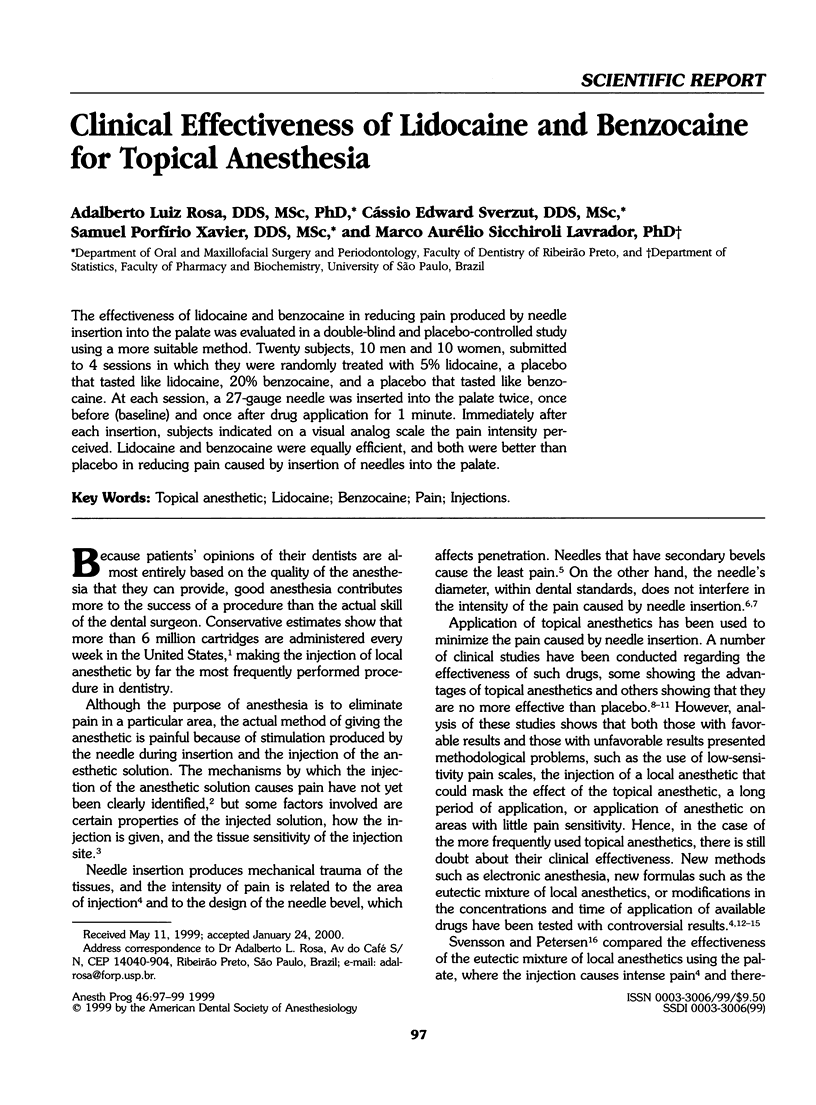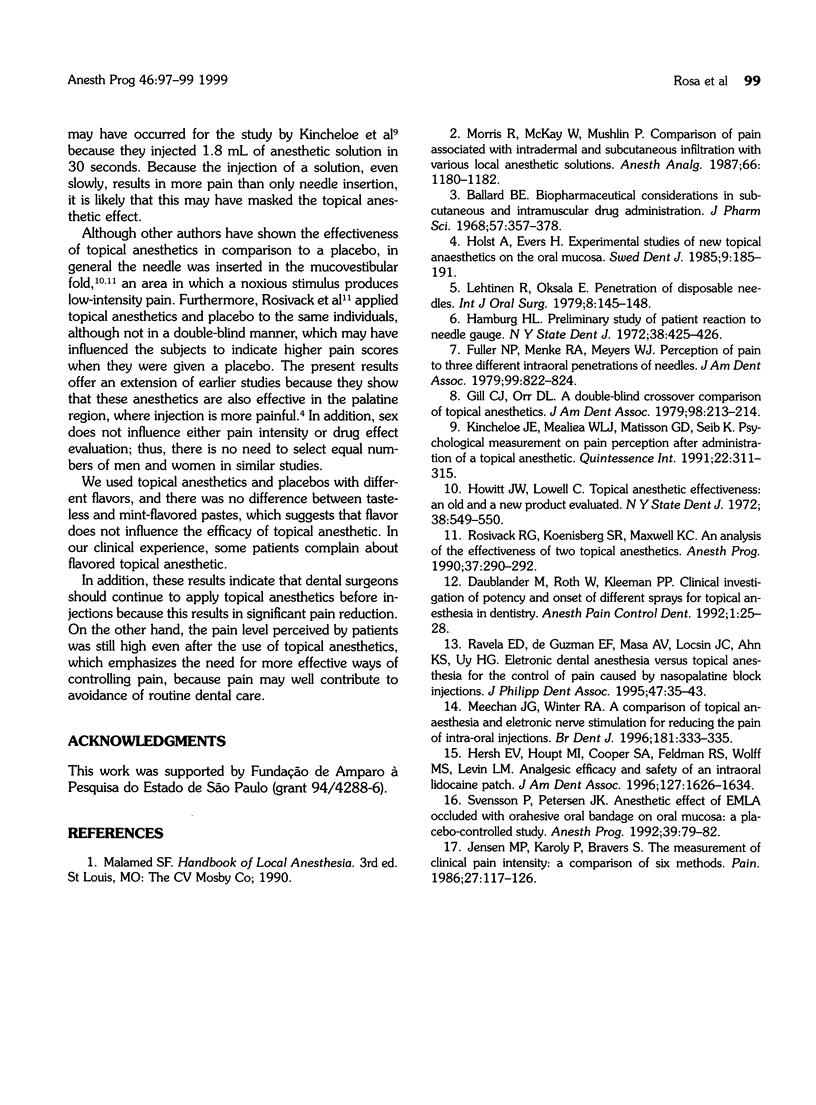Abstract
The effectiveness of lidocaine and benzocaine in reducing pain produced by needle insertion into the palate was evaluated in a double-blind and placebo-controlled study using a more suitable method. Twenty subjects, 10 men and 10 women, submitted to 4 sessions in which they were randomly treated with 5% lidocaine, a placebo that tasted like lidocaine, 20% benzocaine, and a placebo that tasted like benzocaine. At each session, a 27-gauge needle was inserted into the palate twice, once before (baseline) and once after drug application for 1 minute. Immediately after each insertion, subjects indicated on a visual analog scale the pain intensity perceived. Lidocaine and benzocaine were equally efficient, and both were better than placebo in reducing pain caused by insertion of needles into the palate.
Full text
PDF


Selected References
These references are in PubMed. This may not be the complete list of references from this article.
- Ballard B. E. Biopharmaceutical considerations in subcutaneous and intramuscular drug administration. J Pharm Sci. 1968 Mar;57(3):357–378. doi: 10.1002/jps.2600570301. [DOI] [PubMed] [Google Scholar]
- Daubländer M., Roth W., Kleeman P. P. Clinical investigation of potency and onset of different lidocaine sprays for topical anesthesia in dentistry. Anesth Pain Control Dent. 1992 Winter;1(1):25–28. [PubMed] [Google Scholar]
- Fuller N. P., Menke R. A., Meyers W. J. Perception of pain to three different intraoral penetrations of needles. J Am Dent Assoc. 1979 Nov;99(5):822–824. doi: 10.14219/jada.archive.1979.0384. [DOI] [PubMed] [Google Scholar]
- Gill C. J., Orr D. L., 2nd A double-blind crossover comparison of topical anesthetics. J Am Dent Assoc. 1979 Feb;98(2):213–214. doi: 10.14219/jada.archive.1979.0476. [DOI] [PubMed] [Google Scholar]
- Hamburg H. L. Preliminary study of patient reaction to needle gauge. N Y State Dent J. 1972 Aug-Sep;38(7):425–426. [PubMed] [Google Scholar]
- Hersh E. V., Houpt M. I., Cooper S. A., Feldman R. S., Wolff M. S., Levin L. M. Analgesic efficacy and safety of an intraoral lidocaine patch. J Am Dent Assoc. 1996 Nov;127(11):1626–1666. doi: 10.14219/jada.archive.1996.0098. [DOI] [PubMed] [Google Scholar]
- Holst A., Evers H. Experimental studies of new topical anaesthetics on the oral mucosa. Swed Dent J. 1985;9(5):185–191. [PubMed] [Google Scholar]
- Howitt J. W., Lowell C. Topical anesthetic effectiveness. An old and new product evaluated. N Y State Dent J. 1972 Nov;38(9):549–550. [PubMed] [Google Scholar]
- Jensen M. P., Karoly P., Braver S. The measurement of clinical pain intensity: a comparison of six methods. Pain. 1986 Oct;27(1):117–126. doi: 10.1016/0304-3959(86)90228-9. [DOI] [PubMed] [Google Scholar]
- Kincheloe J. E., Mealiea W. L., Jr, Mattison G. D., Seib K. Psychophysical measurement on pain perception after administration of a topical anesthetic. Quintessence Int. 1991 Apr;22(4):311–315. [PubMed] [Google Scholar]
- Lehtinen R., Oksala E. Penetration of disposable needles. Int J Oral Surg. 1979 Apr;8(2):145–148. doi: 10.1016/s0300-9785(79)80010-1. [DOI] [PubMed] [Google Scholar]
- Meechan J. G., Winter R. A. A comparison of topical anaesthesia and electronic nerve stimulation for reducing the pain of intra-oral injections. Br Dent J. 1996 Nov 9;181(9):333–335. doi: 10.1038/sj.bdj.4809252. [DOI] [PubMed] [Google Scholar]
- Morris R., McKay W., Mushlin P. Comparison of pain associated with intradermal and subcutaneous infiltration with various local anesthetic solutions. Anesth Analg. 1987 Nov;66(11):1180–1182. [PubMed] [Google Scholar]
- Ravela E. D., de Guzman E. F., Masa A. V., Locsin J. C., Ahn K. S., Uy H. G. Electronic dental anesthesia versus topical anesthesia for the control of pain caused by nasopalatine block injections. J Philipp Dent Assoc. 1995 Sep-Nov;47(2):35–43. [PubMed] [Google Scholar]
- Rosivack R. G., Koenigsberg S. R., Maxwell K. C. An analysis of the effectiveness of two topical anesthetics. Anesth Prog. 1990 Nov-Dec;37(6):290–292. [PMC free article] [PubMed] [Google Scholar]
- Svensson P., Petersen J. K. Anesthetic effect of EMLA occluded with Orahesive oral bandages on oral mucosa. A placebo-controlled study. Anesth Prog. 1992;39(3):79–82. [PMC free article] [PubMed] [Google Scholar]


